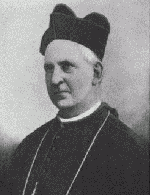Encyclopedia Dubuque
"Encyclopedia Dubuque is the online authority for all things Dubuque, written by the people who know the city best.”
Marshall Cohen—researcher and producer, CNN
Affiliated with the Local History Network of the State Historical Society of Iowa, and the Iowa Museum Association.
HENNESSY, John
HENNESSY, John. (County of Limerick, Ireland, Aug. 20, 1825-Mar. 4, 1900). The son of William and Catherine (Meaney) Hennessy, who were farmers, John Hennessy was educated in local schools and then at private schools with an emphasis on Latin and Greek. He was a student for a short time at All Hallows College, a missionary seminary In Dublin. (1)
In 1847 during the worst year of the Irish famine, Hennessy accepted the invitation of the archbishop of St. Louis to migrate to the United States. He studied for the priesthood at St. Vincent's Seminary in Cape Girardeau, Missouri and Carondelet Seminary near St. Louis. He was ordained a priest for the Archdiocese of Saint Louis on November 1, 1850. (2)
Father Hennessy was assigned to parish work in New Madrid, Missouri and then St. Peter's in Gravois. He then served as a seminary professor and then president at Carondelet, and in 1858 he was sent to the Holy See as a representative of Archbishop Kenrick. It was in Rome, Italy that he learned of his appointment as the third bishop of Dubuque. (3) On April 24, 1866 Pope Pius IX appointed Hennessy as the third bishop of Dubuque. He was consecrated and installed bishop in ST. RAPHAEL'S CATHEDRAL on September 30, 1866 by Archbishop Peter Richard Kenrick of Saint Louis. The principal co-consecrators were Bishops John Martin Henni of Milwaukee and James Duggan of Chicago. Bishop Hennessy attended the First Vatican Council in Rome from 1869–70. He also took a prominent role in the Third Plenary Council of Baltimore in 1884. (4)
The diocese Hennessy served included all of the present state of Iowa. In his travels west to survey his congregation, Hennessy found that farming communities of Catholics had developed across the state. Some were Irish, some Bohemian, and the majority were Irish. Irish priests were attracted from Irish seminaries with first- and second-generation Irish American priests numerous. Bohemian priests also responded to Hennessy's call, but German-speaking priests were scarce. He dealt with the problem for ten years and finally traveled to Europe in 1880 and 1881 in the hopes of finding seminarians and priests. Hennessy's appeals for help led to the Vatican's decision to divide the state into two dioceses with Dubuque responsible for the northern fifty-five counties. (5)
On June 15, 1893, Pope Leo XIII elevated the Diocese of Dubuque to the status of an archdiocese, and Bishop Hennessy became the first Archbishop of Dubuque. The Ecclesial Province of Dubuque included the dioceses of Davenport, Omaha, Wichita and Sioux Falls. (6)
An advocate of Catholic education, Hennessy served from 1866 through 1900, a period of strong anti-Catholic feeling in Dubuque and nationwide. Upon his arrival in Dubuque, Hennessy found twenty-seven priests, thirty churches, two schools and seven sisters. By 1891 under his guidance there were 203 priests, 319 churches, 615 sisters, and over 135 parochial schools attended by 16,257 students. A census bulletin in 1891 showed Dubuque had 303 church organizations and 319 edifices--more than any one archdiocese or diocese in the United States. (7)
Bishop Hennessy received many priests from Germany and Ireland, and in 1873 founded St. Joseph's College and Theological Seminary in Dubuque. Existing parishes were systematically divided, and he directed his energies especially to Christian education. Wherever possible schools were built, and sacrifices were made that every Catholic child should be educated by Catholic teachers. Considerable and continued opposition was offered by some Catholics, not only for economic reasons, but also because they considered the program an attack on the public schools. The wisdom of the bishop was shown by the prosperous condition of the parochial schools, which at the time of his silver Jubilee showed 12,257 pupils enrolled. (8)
In the last years of his life, Hennessy requested that a mortuary chapel be built in St. Raphael's Cathedral. Constructed in the basement of the cathedral, the chapel was completed two years after his death. The remains of bishops Mathias LORAS, Clement SMYTH, and Hennessy were brought to the cathedral and buried in this new chapel. (9)
Archbishop Hennessy left an estate of $700,000 which was divided among several Catholic charities. (10)
---
Source:
1. Hudson, David; Bergman, Marvin; Horton, Loren. The Biographical Dictionary of Iowa. Iowa City: University of Iowa Press, 2008
2. Ibid.
3. Ibid.
4. "John Hennessy," FamPeople.com. Online: http://www.fampeople.com/cat-john-hennessy-bishop
5. Hudson, David
6. Ibid.
7. Ibid.
8. "Archdiocese of Dubuque," Catholic Answer to Explain & Defend the Faith, Online: http://www.catholic.com/encyclopedia/archdiocese-of-dubuque
9. Hudson, David
10. Gallagher, Mary Kevin B.V.M. Seed/Harvest: A History of the Archdiocese of Dubuque. Dubuque, Iowa: Archdiocese of Dubuque Press, 1987



